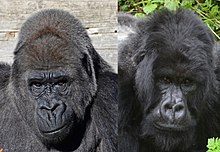 Gorilla
Gorilla
Gorillas are ground-dwelling, predominantly herbivorous apes that inhabit the forests of central Sub-Saharan Africa. The genus Gorilla is divided into two species: the eastern gorillas and the western gorillas (both critically endangered), and either four or five subspecies. They are the largest living primates. The DNA of gorillas is highly similar to that of humans, from 95 to 99% depending on what is included, and they are the next closest living relatives to humans after the chimpanzees and bonobos.
Gorillas' natural habitats cover tropical or subtropical forests in Sub-Saharan Africa. Although their range covers a small percentage of Sub-Saharan Africa, gorillas cover a wide range of elevations. The mountain gorilla inhabits the Albertine Rift montane cloud forests of the Virunga Volcanoes, ranging in altitude from 2,200 to 4,300 metres (7,200 to 14,100 ft). Lowland gorillas live in dense forests and lowland swamps and marshes as low as sea level, with western lowland gorillas living in Central West African countries and eastern lowland gorillasliving in the Democratic Republic of the Congo near its border with Rwanda.
Etymology
The word "gorilla" comes from the history of Hanno the Navigator, (c. 500 BC) a Carthaginian explorer on an expedition on the west Africancoast to the area that later became Sierra Leone. Members of the expedition encountered "savage people, the greater part of whom were women, whose bodies were hairy, and whom our interpreters called Gorillae". The word was then later used as the species name, though it is unknown whether what these ancient Carthaginians encountered were truly gorillas, another species of ape or monkeys, or humans.
The American physician and missionary Thomas Staughton Savage and naturalist Jeffries Wyman first described the western gorilla (they called it Troglodytes gorilla) in 1847 from specimens obtained in Liberia. The name was derived from Ancient Greek Γόριλλαι (gorillai), meaning 'tribe of hairy women', described by Hanno.
Physical characteristics
Gorillas move around by knuckle-walking, although they sometimes walk bipedally for short distances while carrying food or in defensive situations, and some Mountain Gorillas use other parts of their hand to aid locomotion (studies of 77 Mountain Gorillas published in 2018 showed 61% only used knuckle walking, but the remainder used knuckle walking plus other parts of their hand—fist walking in ways that do not use the knuckles, using the backs of their hand, and using their palms). Wild male gorillas weigh 136 to 195 kg (300 to 430 lb), while adult females usually weigh about half as much as adult males at 68–113 kg (150–250 lb). Adult males are 1.4 to 1.8 m (4 ft 7 in to 5 ft 11 in) tall, with an arm span that stretches from 2.3 to 2.6 m (7 ft 7 in to 8 ft 6 in). Female gorillas are shorter at 1.25 to 1.5 m (4 ft 1 in to 4 ft 11 in), with smaller arm spans. Groves (1970) calculates that average weight of the 47 wild adult male gorillas is 143 kg, while Smith and Jungers(1997) found that the average weight of the 19 wild adult male gorillas is 169 kg. Adult male gorillas are known as silverbacks due to the characteristic silver hair on their backs reaching to the hips. The tallest gorilla recorded was a 1.95 m (6 ft 5 in) silverback with an arm span of 2.7 m (8 ft 10 in), a chest of 1.98 m (6 ft 6 in), and a weight of 219 kg (483 lb), shot in Alimbongo, northern Kivu in May 1938. The heaviest gorilla recorded was a 1.83 m (6 ft 0 in) silverback shot in Ambam, Cameroon, which weighed 267 kg (589 lb). Males in captivity are noted to be capable of reaching weights up to 310 kg (683 lb). Gorilla facial structure is described as mandibular prognathism, that is, the mandible protrudes farther out than the maxilla. Adult males also have a prominent sagittal crest.
The eastern gorilla is more darkly coloured than the western gorilla, with the mountain gorilla being the darkest of all. The mountain gorilla also has the thickest hair. The western lowland gorilla can be brown or grayish with a reddish forehead. In addition, gorillas that live in lowland forests are more slender and agile than the more bulky mountain gorillas. The eastern gorilla also has a longer face and broader chest than the western gorilla.
Studies have shown gorilla blood is not reactive to anti-A and anti-B monoclonal antibodies, which would, in humans, indicate type O blood. Due to novel sequences, though, it is different enough to not conform with the human ABO blood group system, into which the other great apes fit. Like humans, gorillas have individual fingerprints. Their eye colour is dark brown, framed by a black ring around the iris.
Credits: Wikipedia
Written By David Davidson.



King Kong.. Nice content
ReplyDeleteThank you boss, stay tuned for more
Delete